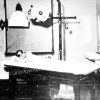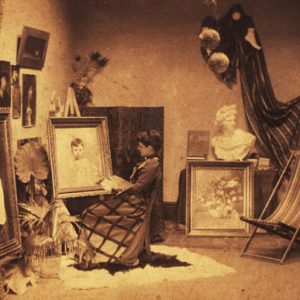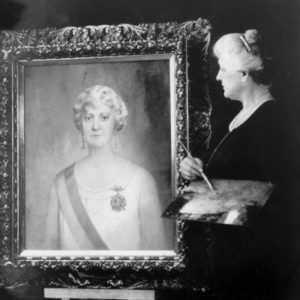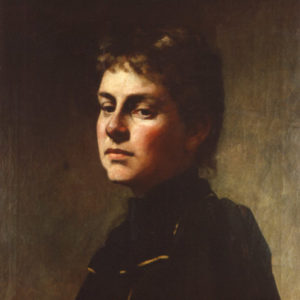calsfoundation@cals.org
Jenny Eakin Delony Rice (1866–1949)
aka: Jenny Delony
aka: Jenny Meyrowitz
Jenny Eakin Delony Rice was the first woman artist from Arkansas to rise to national and international prominence as a painter and the founder of collegiate art education in Arkansas. Though Delony specialized in portraiture, her subject matter included miniatures, landscape, wildlife, still life, and genre (scenes of everyday life).
Jenny Delony was born in Washington (Hempstead County) on May 13, 1866, to Alchyny Turner Delony, a capitalist, lawyer, and educator, and Elizabeth Lawson Pearson Delony, a teacher. She had four siblings. The Delony family lived in Washington until 1885, when they moved to Nashville (Howard County). In 1890, the Delonys moved to Little Rock (Pulaski County). After finishing elementary schooling in Washington, Delony attended Wesleyan Female Institute (Stuart Hall) in Staunton, Virginia, probably from 1878 to 1882. She won gold medals there in both art and music.
Delony began her professional study at Cincinnati Academy of Art from 1886 to 1888. At least two years followed in Paris, where Delony studied at the Académie Julian, the Académie Delécluse, and in the atelier of painter Paul Délance. Next, she studied at the St. Louis School of Art from March 14, 1892, to February 10, 1893. She studied in Venice sometime prior to 1895 with Italian genre painter Stefano Novo. In 1896, the first year women were admitted to the École des Beaux Arts in Paris, she entered as one of the historic firsts. She made history again that same year as one of the first women to study artistic anatomy at the École de Médecine in Paris. She also studied under the American painter William Merritt Chase and was his personal secretary at the Chase Art School, also called Shinnecock, at Southampton on Long Island.
Delony married twice. Her first marriage was to Nathaniel J. Rice of Denver, Colorado, on December 10, 1891. He died within two years of their marriage. Her second marriage was to prominent New Yorker Paul A. Meyrowitz, on November 19, 1910. It was not a happy marriage, and they quietly separated in the early 1920s. After the separation, she returned to the signature “Delony Rice” on her paintings. She had no children.
Delony established her first professional art studio in 1891 in Little Rock. Her second studio in Little Rock in 1897 occupied suites twenty-eight and twenty-nine of the Masonic Temple on Main Street.
During the 1880s and 1890s, she painted portraits of many of the most distinguished citizens. She represented the state regionally and nationally at various exhibitions: the New Orleans Cotton Centennial Exposition (1885), the State Exposition in Little Rock (1887), the Columbian Exposition in Chicago (1893), and the Cotton States and International Exposition in Atlanta (1895). She won premiums for many works exhibited.
Rice taught art in Virginia for three years, first at Virginia Female Institute in Roanoke (1893–1894), then Norfolk College for Young Ladies in Norfolk (1894–1896). From 1897 to 1900, Rice was the first Director of Art for Arkansas Industrial University, which became during her tenure the University of Arkansas (UA) in Fayetteville (Washington County). There, she founded the art department and the first baccalaureate art program in the state. While in Fayetteville, she produced a special college edition of the Arkansas Gazette and compiled and edited the university’s Cardinal yearbook.
Rice left Fayetteville to set up a studio in New York in 1900. In 1903, she exhibited at the National Academy of Arts. Her miniature of Queen Victoria was exhibited at Tiffany’s. In her role as suffragette and artist, she was chosen to represent American women as an exhibitor at the International Council of Women in Berlin, Germany, which convened June 6–18, 1904. In 1905, her portrait of the “richest woman in America,” Hetty Green, was featured as a full page in the New York Times, granting the artist instant celebrity; the portrait is now in the collection of the Historic Arkansas Museum in Little Rock.
Around 1935, the artist retired from the New York art scene and returned to Little Rock. She had a studio in her home, and she continued to paint during retirement. Sometime after her return to Little Rock, Rice had surgery for cancer. However, the cancer returned and metastasized, and she died on April 1, 1949. She is buried at Oakland Cemetery in Little Rock.
Many examples of Rice’s work can be viewed today in public collections. A portrait of an African American and many other works are at the Historic Arkansas Museum. The portraits of Governor George Washington Donaghey, Logan H. Roots, J. T. W. Tillar, and Confederate president Jefferson Davis are at the Arkansas State Archives. Her portrait of Governor Thomas Chipman McRae is located on the North Wing, first floor of the Arkansas State Capitol. Historic Washington State Park has the portrait titled A Southern Gentleman. The portrait of Bishop Henry Nils Pierce is in the office of the Diocese of Arkansas at Trinity Episcopal Church in Little Rock. Her last commission, La Grange College, is in the Leighton Public Library in Leighton, Alabama.
For additional information:
Baker, Linda Hastings. “Jenny Eakin Delony (1866–1949): Portraitist and Miniature Painter.” MA thesis, University of Arkansas at Little Rock, 1993.
“Former Arkansan Paints Portraits.” Arkansas Gazette. May 20, 1923, p. 16.
Opitz, Glen B., ed. Mantle Fielding’s Dictionary of American Painters, Sculptors, and Engravers. Poughkeepsie, NY: Apollo, 1987.
Who’s Who in America 1948–1949. Vol. 25. Chicago: A. N. Marquis, 1949.
Linda Hastings Baker
Little Rock, Arkansas
 Arts, Culture, and Entertainment
Arts, Culture, and Entertainment Early Twentieth Century, 1901 through 1940
Early Twentieth Century, 1901 through 1940 Jenny Delony
Jenny Delony  Psyche by Jenny Eakin Delony
Psyche by Jenny Eakin Delony  Jenny Rice
Jenny Rice  Jenny Rice
Jenny Rice 




Comments
No comments on this entry yet.